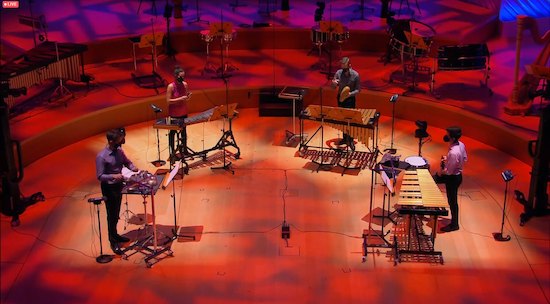New World Percussion Consort opens virtual season with several bangs

The ideal live performance probably doesn’t entail experiencing the music through the twin speakers of a desktop computer.
But that’s where we are. And while such an arrangement is particularly unfavorable for a percussion concert, where you want to feel the bangs, raps and boinks as physically as possible, the New World Percussion Consort made the best of a bad situation in its concert Saturday night.
The concert, delivered via the classical streaming service IDAGIO and accessible for 72 hours afterward, took place at New World Center in Miami Beach, where masked performers took the stage and sad blocks of empty seats could be seen in the darkened hall. There was no applause, of course, and so the performers applauded each other or exchanged air high fives.
Prepared under the leadership of Michael Linville, New World’s dean of chamber music, the music spanned a vast range, from austere, rhythm-dominated works to lush, Asian-influenced compositions with soaring melodies and rich harmonies. All of the works came from the 20th and 21st centuries, a period that saw many composers move past the traditional ensembles of Haydn, Schumann and Brahms to produce viola sonatas, tuba concertos and, of course, works for groups of percussion instruments.
The evening began with Iannis Xenakis’s Okho for three West African drums called djembes. An architect and engineer, Xenakis relied heavily on mathematics in creating his works, an approach that grouped him with the 20th century composers often seen as more theoretical and cerebral than inspired.
His 1989 work Okho, however, had an earthy force that came through in the growing complexity and force of the drum rhythms. An advantage of the online performance became apparent in close-ups that revealed the technique behind the sounds, as drummers Kevin Ritenauer,Charlie Rosmarin and Marcelina Suchocka produced a wide range of tones depending on how they struck the drums, whether with fingertips or palms, or in the center or at the edge of the instrument.
More accessible were the playful rhythms of Movement III from A la Par, a 1986 work by Tania León, a Cuba-born composer who now lives in upstate New York. With Thomas Steigerwald at the piano, the percussionistSuchocka moved like a busy short-order cook among two sets of mallet instruments, drums and various other instruments, producing a jaunty interlude that sounded like a dance hall seen through a funhouse mirror.
Harder to appreciate was the third movement from William Kraft’s Suite for Percussion from 1958. A former percussionist and principal timpanist of the Los Angeles Philharmonic, Kraft composed his suite as part of the marketing campaign for a company that manufactured drumheads. Dominated by one rhythmic motif, the work used drums, brushes and a tambourine during its brief span.
The American composer Henry Cowell’s Ostinato Pianissimo for Percussion Orchestra called for nine musicians on a variety of instruments. Performing the piece at all appeared to be quite a feat, since several of the musicians appeared to be playing in separate rooms around New World Center. Particularly effective was Charlie Rosmarin’s solo on the xylophone, an eerie melody that danced over the tones of the other instruments.
Also striking were the Movements II and XI from Lou Harrison’s Music for Harp and Percussion. Harpist Phoebe Powell deftly played a long, fast-paced melody over the percussion in the first section. The second felt particularly Eastern in tone and melodic turns, its texture marked by bright, sparkling percussion tones.
The French-born, Brooklyn-based composer Daniel Wohl’s Replicate (Part 2) for percussion and electronics had a sense of narrative that many of the other works lacked. It began with spacey electronic beeps and flute-like tones over percussion, music that felt formless and random. Video by Clyde Scott consisted of patterns of light in green, red, blue and orange, appearing in its abstract complexity like an electronic Spirograph.
After a few minutes of this, the music resolved into the sweeter tones of two mallet instruments playing arpeggios that rolled up and down in consonant, gentle harmonies, providing a sort of aural comfort and repose after the preceding episodes of chaos.
The big work on the program engaged the long-standing debate over whether the piano is a percussion instrument. Twentieth-century composers such as Bartók and Prokofiev emphasized the instrument’s percussive qualities, and Bartók’s Sonata for Two Pianos and Percussion achieved a natural and effective integration of the piano with more traditional percussion instruments.
Pianists Wesley Ducote and Thomas Steigerwald played the opening in an eerie manner, their tones made more portentous by the beats from timpanist Matthew Kibort. Both pianists appeared to have no trouble with the music’s virtuoso demands, as the music ranged from Gershwinesque swagger to gnarly, harmonically dense introspection.
Although the pianos generally took the lead voices, the percussion was vital to creating the atmosphere. In the second movement’s opening, for example, a spare melody in the piano became particularly ominous with the rumble of drums and hiss of the cymbal.
In the last movement, Kevin Ritenauer skillfully played a lively theme on the xylophone, which in context sounded like a richer, more rounded version of the piano’s upper range. The movement ranged from ghostly to marchlike and precise, building to a roiling climax with the two pianists’ hands running rapidly up and down the keyboards.
The concert can be viewed on IDAGIO through 9 p.m. Monday. Go to nws.edu or idagio.com.
Posted in Performances
Leave a Comment
Sun Oct 11, 2020
at 1:34 pm
No Comments






